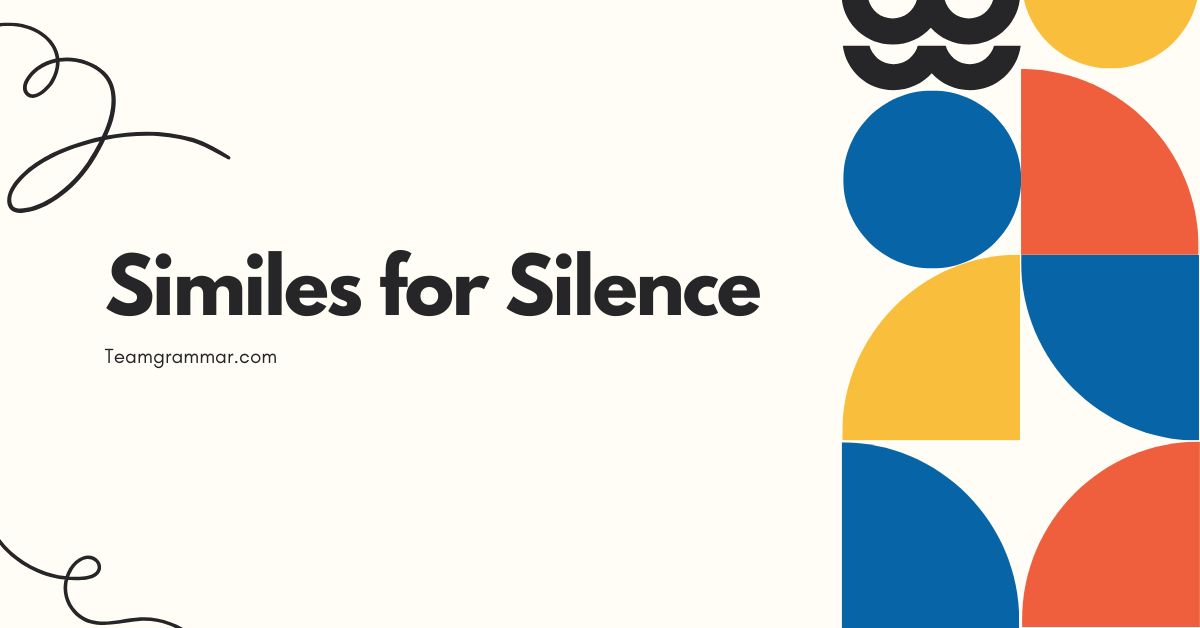51 Similes for Silence: Mastering Figurative Language
Silence, often perceived as the absence of sound, holds profound significance in communication, emotions, and atmosphere. Understanding how to describe silence effectively enhances our ability to convey nuanced meanings and vivid imagery in both writing and speech.
This article delves into the world of similes for silence, exploring their structure, types, and usage. Whether you’re a student, writer, or language enthusiast, this comprehensive guide will equip you with the knowledge and tools to master the art of describing silence with creativity and precision.
By the end of this article, you’ll be able to craft compelling descriptions that resonate with your audience, adding depth and impact to your communication.
Table of Contents
- Introduction
- Definition of a Simile for Silence
- Structural Breakdown of Similes for Silence
- Types and Categories of Similes for Silence
- Examples of Similes for Silence
- Usage Rules for Similes for Silence
- Common Mistakes When Using Similes for Silence
- Practice Exercises
- Advanced Topics in Similes for Silence
- Frequently Asked Questions (FAQ)
- Conclusion
Definition of a Simile for Silence
A simile for silence is a figure of speech that compares silence to something else using the words “like” or “as.” It’s a way to describe the quality, intensity, or effect of silence by drawing a parallel to a more tangible or easily understood concept. Similes help create vivid mental images and evoke specific emotions related to silence.
They are invaluable tools for writers and speakers seeking to add depth and nuance to their descriptions.
The primaryfunctionof a simile for silence is to enhance descriptive writing. Instead of simply stating that something is silent, a simile provides a more imaginative and evocative comparison.
This technique allows the writer to convey not just the absence of sound, but also the feeling, atmosphere, or impact of that silence.
Contextsin which similes for silence are used vary widely. They can appear in literature, poetry, journalism, and everyday conversation.
In literature, they often contribute to setting the mood or revealing a character’s inner state. In journalism, they might describe the atmosphere of a crime scene or a political protest.
In everyday conversation, they can add emphasis or humor to a description of a quiet place or situation.
Structural Breakdown of Similes for Silence
A simile, in general, consists of three essential elements: the subject (in this case, silence), the linking word (“like” or “as”), and the object of comparison (the thing that silence is being compared to). Understanding these elements is crucial for constructing effective similes.
The basic formula for a simile for silence is: Silence + like/as + Object of Comparison. For example: “Silence like a tomb” or “Silence as deep as space.”
Let’s break this down further:
- Silence: The subject of the comparison. This is what we are trying to describe.
- Like/As: The linking word that establishes the comparison.
- Object of Comparison: The thing that silence is being compared to. This could be anything that shares a similar quality or evokes a similar feeling.
The effectiveness of a simile hinges on the appropriateness and vividness of the object of comparison. A strong simile creates a clear and memorable connection between silence and the chosen object, enhancing the reader’s understanding and emotional response.
Types and Categories of Similes for Silence
Similes for silence can be categorized based on the quality or aspect of silence they emphasize. Here are a few common categories:
Similes Emphasizing Depth or Profoundness
These similes highlight the intensity and significance of silence, often suggesting a sense of awe or solemnity.
Similes Emphasizing Stillness or Lack of Movement
These similes focus on the absence of activity or motion, creating a sense of tranquility or anticipation.
Similes Emphasizing Emptiness or Absence
These similes underscore the void or lack of presence, suggesting loneliness, desolation, or loss.
Similes Emphasizing Tension or Foreboding
These similes create a sense of unease or anticipation, suggesting that something significant is about to happen.
Similes Emphasizing Peace or Serenity
These similes evoke a sense of calm and tranquility, suggesting a state of relaxation or meditation.
Examples of Similes for Silence
Here are several examples of similes for silence, organized by the categories mentioned above. Each example aims to illustrate the diversity and effectiveness of this figurative language technique.
Examples Emphasizing Depth or Profoundness
These similes aim to capture the profound and meaningful nature of silence, often suggesting a sense of reverence or deep contemplation.
| Simile | Explanation |
|---|---|
| Silence like a cathedral. | Evokes a sense of sacredness and grandeur. |
| Silence as deep as the ocean. | Suggests an unfathomable and mysterious depth. |
| Silence like a held breath. | Implies anticipation and a sense of importance. |
| Silence as heavy as a tombstone. | Highlights the weight and solemnity of the moment. |
| Silence like the eye of a hurricane. | Suggests a deceptive calm before or after a storm. |
| Silence as profound as a philosopher’s thought. | Highlights the depth and thoughtfulness associated with silence. |
| Silence like the hush before a symphony. | Evokes anticipation and a sense of something grand about to happen. |
| Silence as deep as the void between stars. | Suggests an infinite and awe-inspiring emptiness. |
| Silence like the stillness of a sacred grove. | Implies a sense of reverence and connection to nature. |
| Silence as heavy as unspoken grief. | Highlights the emotional weight and burden of unexpressed sorrow. |
| Silence like a moment of revelation. | Suggests a profound understanding or insight gained in the quiet. |
| Silence as deep as a well of secrets. | Implies hidden depths and untold stories. |
| Silence like the calm before the storm. | Evokes a sense of impending change or conflict. |
| Silence as heavy as a king’s crown. | Highlights the burden and responsibility associated with power. |
| Silence like the echo of a forgotten prayer. | Suggests a lingering sense of spirituality or longing. |
| Silence as vast as the desert night. | Implies an endless and desolate emptiness. |
| Silence like the pause in a heartbeat. | Evokes a sense of fragility and the preciousness of life. |
| Silence as deep as the roots of an ancient tree. | Suggests a connection to history and the passage of time. |
| Silence like the space between musical notes. | Highlights the importance of silence in creating harmony and rhythm. |
| Silence as heavy as a guilty conscience. | Implies the burden of wrongdoing and the weight of remorse. |
| Silence like a sanctuary. | Evokes a sense of peace and refuge. |
| Silence as thick as fog. | Suggests obscurity and a sense of being lost. |
Examples Emphasizing Stillness or Lack of Movement
These similes focus on the absence of motion and activity, often creating a sense of peace, anticipation, or stagnation.
| Simile | Explanation |
|---|---|
| Silence like a frozen lake. | Suggests a smooth, undisturbed surface and a lack of movement. |
| Silence as still as a statue. | Emphasizes the complete absence of motion. |
| Silence like a sleeping city. | Evokes a sense of peaceful inactivity. |
| Silence as quiet as a mouse. | Highlights the unobtrusive and gentle nature of the stillness. |
| Silence like a stopped clock. | Suggests a pause in time and a sense of stagnation. |
| Silence as motionless as a painting. | Emphasizes the fixed and unchanging nature of the scene. |
| Silence like a world holding its breath. | Evokes a sense of anticipation and suspense. |
| Silence as still as a held note. | Suggests a sustained and unwavering quietude. |
| Silence like a room after everyone has left. | Implies emptiness and a lack of activity. |
| Silence as undisturbed as a mirror’s surface. | Highlights the unblemished and reflective quality of the stillness. |
| Silence like a cathedral after hours. | Evokes a sense of sacred stillness and emptiness. |
| Silence as still as death. | Highlights the ultimate cessation of movement and life. |
| Silence like a stone in a pond. | Suggests a lack of ripples or disturbance. |
| Silence as quiet as the eye of a needle. | Emphasizes the minute and precise nature of the quietude. |
| Silence like the calm after a storm. | Implies a sense of peace and tranquility after a period of turmoil. |
| Silence as still as the night sky. | Evokes a sense of vastness and undisturbed peace. |
| Silence like a library at dawn. | Suggests a quiet and studious atmosphere. |
| Silence as quiet as a secret. | Implies discretion and a lack of revelation. |
| Silence like a forest holding its breath. | Evokes a sense of natural stillness and anticipation. |
| Silence as still as a photograph. | Highlights the frozen moment in time. |
| Silence like a dream. | Evokes a sense of peace and tranquility. |
| Silence as still as space. | Suggests an infinite and undisturbed quietude. |
Examples Emphasizing Emptiness or Absence
These similes highlight the void and lack of presence, often conveying feelings of loneliness, desolation, or loss.
| Simile | Explanation |
|---|---|
| Silence like an empty house. | Suggests a lack of occupants and a sense of loneliness. |
| Silence as hollow as a drum. | Emphasizes the lack of substance and depth. |
| Silence like a ghost town. | Evokes a sense of abandonment and desolation. |
| Silence as barren as a desert. | Highlights the lack of life and vitality. |
| Silence like a forgotten memory. | Suggests a loss of significance and relevance. |
| Silence as empty as a broken promise. | Emphasizes the disappointment and void left behind. |
| Silence like a heart without love. | Evokes a sense of emotional emptiness and longing. |
| Silence as hollow as a politician’s words. | Suggests a lack of sincerity and substance. |
| Silence like a room where laughter used to be. | Implies a loss of joy and happiness. |
| Silence as empty as a well without water. | Highlights the lack of sustenance and fulfillment. |
| Silence like a vacant stare. | Evokes a sense of detachment and lack of engagement. |
| Silence as empty as a beggar’s bowl. | Suggests a lack of resources and a sense of destitution. |
| Silence like a stage after the curtain falls. | Implies the end of a performance and a return to emptiness. |
| Silence as barren as a winter tree. | Highlights the lack of foliage and life in the dormant season. |
| Silence like a song without music. | Suggests a lack of harmony and expression. |
| Silence as empty as a page without words. | Emphasizes the lack of content and communication. |
| Silence like a house after the family has moved away. | Evokes a sense of loss and abandonment. |
| Silence as hollow as a skull. | Suggests the absence of thought and life. |
| Silence like a mirror reflecting nothing. | Implies a lack of substance and identity. |
| Silence as empty as a thief’s heart. | Highlights the lack of compassion and empathy. |
| Silence like a closed book. | Evokes a sense of mystery and unread stories. |
| Silence as empty as a promise unfulfilled. | Suggests disappointment and a lack of completion. |
Usage Rules for Similes for Silence
Using similes effectively requires attention to several key rules. These rules ensure that your similes are clear, impactful, and appropriate for the context.
- Clarity: The object of comparison should be easily understood by your audience. Avoid obscure or overly complex references.
- Relevance: The comparison should be logically connected to the aspect of silence you are trying to emphasize.
- Originality: While common similes can be effective, strive for originality to make your writing more engaging and memorable.
- Context: Consider the tone and purpose of your writing. A simile that is appropriate in a poem might not be suitable for a scientific report.
- Avoid Clichés: Steer clear of overused similes that have lost their impact through repetition.
Exceptions:There are times when breaking these rules can be effective, particularly in creative writing. For example, using an obscure reference can create a sense of mystery or intrigue.
However, these exceptions should be used deliberately and with careful consideration.
Common Mistakes When Using Similes for Silence
Several common mistakes can undermine the effectiveness of similes. Being aware of these pitfalls can help you avoid them.
| Incorrect | Correct | Explanation |
|---|---|---|
| Silence like a loud noise. | Silence like a tomb. | The comparison should be logical and relevant. |
| Silence as like a whisper. | Silence like a whisper. | Avoid redundant use of “like” and “as.” |
| Silence like… stuff. | Silence like a forgotten song. | The object of comparison should be specific and evocative. |
| Silence as a brick. | Silence as heavy as a brick. | Ensure the comparison is grammatically correct and clear. |
| Silence like the color blue. | Silence like a still, blue lake. | The object of comparison should relate to the quality being described. |
Practice Exercises
Test your understanding of similes for silence with these exercises. Fill in the blanks to complete the similes.
- Silence like __________.
- Silence as deep as __________.
- Silence like a __________.
- Silence as still as __________.
- Silence like an __________.
- Silence as empty as __________.
- Silence like a __________.
- Silence as quiet as __________.
- Silence like the __________.
- Silence as profound as __________.
Answer Key:
- Silence like a tomb.
- Silence as deep as the ocean.
- Silence like a sleeping city.
- Silence as still as a statue.
- Silence like an empty house.
- Silence as empty as a broken promise.
- Silence like a frozen lake.
- Silence as quiet as a mouse.
- Silence like the calm before the storm.
- Silence as profound as a philosopher’s thought.
Exercise 2: Create Your Own Similes
Write five original similes for silence, focusing on different aspects of silence (depth, stillness, emptiness, tension, peace).
Exercise 3: Identify the Type of Simile
For each of the following similes, identify the category it belongs to (Depth, Stillness, Emptiness, Tension, Peace):
- Silence like a held breath.
- Silence as still as a frozen lake.
- Silence like an empty house.
- Silence as quiet as the eye of a hurricane.
- Silence like a sanctuary.
Answer Key:
- Tension
- Stillness
- Emptiness
- Tension
- Peace
Advanced Topics in Similes for Silence
For advanced learners, exploring the nuances of similes for silence can involve examining their use in literature, their cultural significance, and their connection to other figures of speech.
Literary Analysis: Analyze how famous authors use similes for silence to create specific effects in their works. Consider the context, the author’s intent, and the overall impact of the simile.
Cultural Significance: Explore how different cultures perceive and describe silence. Are there specific similes or metaphors that are unique to certain cultures?
Connection to Other Figures of Speech: Compare and contrast similes with metaphors, personification, and other figures of speech. How do these techniques work together to enhance descriptive writing?
Frequently Asked Questions (FAQ)
- What is the difference between a simile and a metaphor?
Both similes and metaphors are figures of speech that compare two unlike things. However, a simile uses the words “like” or “as” to make the comparison explicit, while a metaphor implies the comparison without using these words. For example, “Silence like a tomb” is a simile, while “Silence was a tomb” is a metaphor.
- How can I make my similes more original?
To create original similes, think beyond the obvious and look for unexpected connections between silence and other things. Consider using sensory details to make your comparisons more vivid and engaging. Also, try to avoid clichés and overused phrases.
- What are some common mistakes to avoid when using similes?
Some common mistakes include using illogical comparisons, being redundant with “like” and “as,” and using vague or generic objects of comparison. Always ensure that your similes are clear, relevant, and grammatically correct.
- How important is context when using similes?
Context is crucial. A simile that works well in one situation might be inappropriate in another. Consider the tone, purpose, and audience of your writing when choosing a simile.
- Can a simile be too complex?
Yes, a simile can be too complex if it uses obscure references or convoluted language that your audience cannot easily understand. The goal is to enhance clarity, not to confuse the reader.
- How do I choose the right object of comparison for a simile?
Choose an object of comparison that shares a similar quality or evokes a similar feeling to the aspect of silence you are trying to emphasize. Consider the sensory details associated with the object and how they might enhance the reader’s understanding.
- Are there cultural differences in understanding similes for silence?
Yes, cultural backgrounds can influence the interpretation of similes. Certain objects or concepts may carry different connotations in different cultures, affecting how the simile is understood. It’s important to be mindful of your audience’s cultural background when using similes, especially when writing for an international audience.
- How can I practice using similes for silence?
Practice by writing descriptive passages that incorporate similes for silence. Experiment with different objects of comparison and pay attention to the effect they have on the overall tone and imagery of your writing. You can also analyze the use of similes in the works of other writers.
- Can similes for silence be used in spoken language effectively?
Absolutely! Similes for silence can be very effective in spoken language to add emphasis and create vivid imagery. However, it’s important to use them judiciously and ensure they are easily understood by your audience. Overusing similes in speech can sound contrived or unnatural.
Conclusion
Mastering similes for silence can significantly enhance your descriptive writing and speaking abilities. By understanding the structure, types, and usage rules of similes, you can craft compelling descriptions that resonate with your audience.
Remember to focus on clarity, relevance, and originality, and to avoid common mistakes. Practice regularly, and you’ll soon be able to use similes for silence with confidence and creativity.
The ability to describe silence effectively opens up new avenues for expression, allowing you to convey nuanced meanings and evoke powerful emotions.
By exploring advanced topics and analyzing the use of similes in literature, you can further refine your skills and gain a deeper appreciation for the art of figurative language. Embrace the challenge of creating original and impactful similes, and you’ll discover the power of silence as a subject of rich and evocative description.
Continue to experiment with different comparisons and contexts, and you will undoubtedly elevate your communication skills to new heights.







